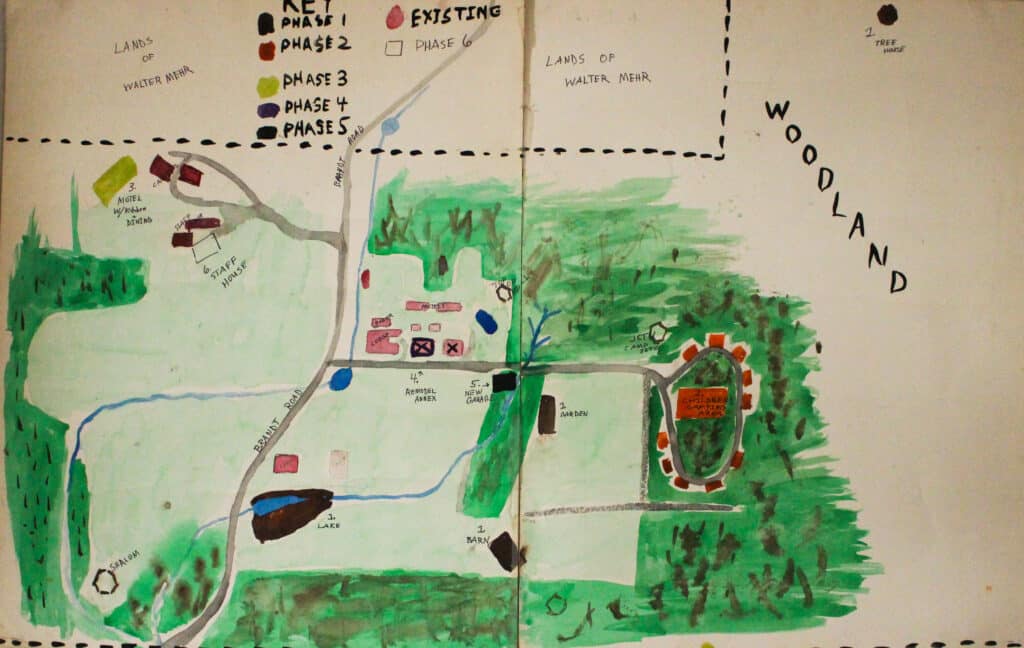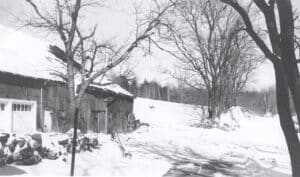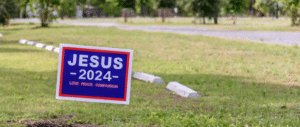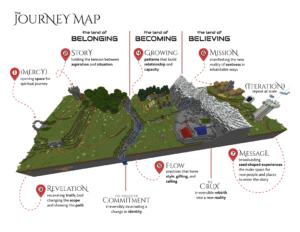Hopes and Dreams
From when camp was purchased until the present time, many people have dreamed of new camping facilities. The vision included new cabins and a separate dining hall for children’s camps and converting existing buildings, such as Spruce Lodge, into an area solely for congregational retreats and family vacations.
When the Brandt Road property was purchased, it was a turnkey operation that allowed the city churches to open camp within a month of purchase. The main lodge and other buildings were in good enough shape to allow children’s camps to begin in the summer of 1969. However, there was always a vision that Camp Deerpark would eventually have cabins like other camps. The general understanding of camping in the 1950s and ’60s was of children with a counselor in cabins or tents. All of the camping that the New York City Mennonites had done up to that point was with the cabin model.
Dale remembers sitting on a large rock in the early 1970s, in the general area where Promise Woods now exists, envisioning a circle of cabins to serve the children’s camping program. “That was the only place I ever thought about having them,” Dale said. “It had a nice view and the ground was level enough to make it work.” Dale recalled one week in the early 1970s when there were 82 campers. “Some of the campers had to stay with their counselor in a trailer behind the motels,” Dale said. “It made us focus again on the need for better and expanded facilities.”

Glenn Zeager dreamed of having a lake. “A great deal of thought went into trying to make a lake,” Dale said. “We had an environmental officer from New York state visit camp to see if it was possible.” Gene Shelly noted, “There just wasn’t enough water year round to make it feasible, and it wasn’t recommended.”
Richard Frey remembered there was also a dream of building a gym to go along with the cabins. “I was a board member for a number of years,” he said. “We struggled with the huge gap between dreams and reality. In those years, the volunteers and staff of the churches organized basketball and softball teams as a means of engaging with the youth of the churches and neighborhood. The pastors and board dreamed of building a gym at camp where they could share the gospel and hold tournaments. The limited financial resources of the camp prevented their dream from becoming a reality.”
Paying the bills at camp was challenging and the vision for new cabins was put on hold. A new pool and a raised chapel with an added basement were achievements in the early years, and those facilities have been well used.
In 1982 a development committee including Dale Stoltzfus, Jim Baer, Frank Freeman, Gene Shelly, and Lowell Jantzi (chair); was established to again envision a new building phase. The committee helped define Camp Deerpark’s philosophy with the following goals:
1. To provide a setting (place) where people can experience the presence of God in new forms from urban life.
2. To assist congregations in retreating, meditation, new forms of worship.
3. To provide a setting for leadership training development.
4. To provide a model for Christian discipleship and modeling of the Christian life.
5. To provide Christian education for children, youth and adults.
6. To provide a place for urban youth to experience life in a rura latmosphere.
7. To assist congregations in spiritual, physical and emotional renewal.
8. To provide possibilities of sharing of life between rural and urban congregations and persons.
The committee proposed six building phases. This watercolor, by Jim Baer, roughly illustrated some of the plans.
1. Barn for animals, lake, garden, tree house
2. Children’s facilities
a. 10 cabins
b. One dining room
c. Play area
3. New 4–6 unit motel building on top of hill next to the existing two cabins
4. Remodel Annex into coffee shop, snack shop hall
5. New garage along back path and current garage turned into picnic area
6. House for long-term and summer staff (to replace trailers)
From Development Committee minutes, 3/25/1983.
On November 17, 1984, Dale Stoltzfus presented an extensive long-range plan to the board. This plan included a Spruce Lodge dining room expansion, a bookstore, motel renovations and conversion of a trailer into a pastors’ retreat.
In the first paragraph in the report, Dale stated, “There are a variety of ways to understand and share dreams. It is not always clear when dreams should be shared and with whom they should be shared. Many people over the years have had some dreams about the development of Camp Deerpark. In recent years there have been dreams about the development of additional facilities and program. This would free the present facilities to be used and upgraded as a retreat center.”
During this time, camp was looking for ways to accommodate a growing request for smaller retreat groups and multiple groups per weekend. Building cabins was still a dream, but one that also now felt like a necessity if camp was to continue to flourish and grow.
In 1985, a September report to the board focused on the construction of the children’s camping area. A budget of $146,000 was projected to complete 10 cabins and a dining room. Also proposed was a two-story building with 24 beds to be constructed near existing cabins on the hill. Several perk tests and deep soil tests were conducted in preparation for a sewer system.But proper soil was never found. Due to a combination of poor soil and alack of funds, the children’s camp cabins were put on hold once again.

“From 1996 to 1999 we experienced significant growth in retreat and summer camp usage,” said Ken. “Across the country this was a very strong time for Christian camping. Then in the summers of 1998 to 2000 we experienced sewer failure. We made several attempts to patch the problem with little success. At the October 28, 2000 board meeting, the decision was made to no longer patch the problem and take steps toward a completely new system. Jesus Cruz was a strong voice urging us to invest in a new system.” In 2003 a new sewer system was installed (where the baseball field used to be) that would handle up to 150 people.
With a new sewer system in place, the possibility of expanded facilities was again back on the table. Jerry Kennell was asked to help camp think through expansion plans in 2005. Four task force groups were established to look at:
1. Children’s camp facilities
2. Adult retreat facilities
3. Sustained funding
4. Strengthened relationship with owner churches
In 2006, following Jerry Kennell’s advice, a Site Plan Task Force was established and a site plan architect was hired. A task force interviewed several architects and hired Howard Deardorf from Michigan.
On June 16, 2007, the Site Plan Task Force presented to the camp board a plan that included:
1. Staff housing
2. Maintenance building
3. Children’s camp cabins and dining room
4. Gymnasium and swimming pool
5. Family cabins
A feasibility study was presented to more than 30 donors over the summer of 2007 with an overwhelmingly positive response. In January of 2008 the board launched a $3.5 million campaign entitled “A Time to Build” to cover the five projects listed above. In December 3, 2012, construction began on an expanded sewer system to accommodate all of the children’s camp village and family cabins making the total capacity 200 guests. And in June of 2015, four Promise Woods cabins were dedicated and placed into service.

Mennonite, Forest Hills Mennonite and Evangelical Garifuna Church.
The movement toward completing the five areas continues, as four more children’s cabins are presently being built. A multi-purpose facility—the Promise Woods Program Center—will be framed in the summer of 2019. By June of 2020 the goal is to have two additional cabins (six total) and the program center in service.
—Written by Ken Bontrager and Donna Stoltzfus.
Richard Frey, a former board member and youth leader, attended Glad Tidings Mennonite Church in the Bronx.
Eugene Shelly, a camp pastor, served as minister of Glad Tidings Mennonite Church in the Bronx from 1967–1978.
Dale Stoltzfus, first director of camp, attended Glad Tidings Mennonite Church in the Bronx.
Related Entries
Share:
Pain and Need Aren’t Partisan
This is Session 3 of the Prince of Peace: Jesus and Peacebuilding from the Election to the Holidays webinar series. (Click here to sign up for session invites.) Sometimes people seem so different from us, we automatically assume we can’t connect. Or, we tried to connect on some level, but it quickly became way too…
What is A Mission Statement?
On the LMC NYC District call this month, Dr. Tiffany shared critical information on what is and what is not a mission statement. This is critical as we think about moving the congregations in our district forward towards mission, optimize the mission already underway, and align together on the LMC mission as district churches. In…
Advent Calendar
Count Down the Days to Christmas with Camp! Jesus is the center of our Camp community. Let’s celebrate together the coming of the One who brings peace and salvation and life everlasting to humanity. We’ll be posting each day to Facebook and Instagram stories, but you can get our daily post in your email inbox!…
A Spirit-filled Christmas: The Joy in Judgement
The end of this week (Black Friday) marks the beginning of the Christmas season for many. (Though the big-box retailers had stuff out before Halloween, can you believe it!?!) For our culture, this season is a time of Joy. We gather for feasting and presents and the delighting of children. And despite the growing chill…
From Inner Peace to the Holiday Table
This is Session 2 of the Prince of Peace: Jesus and Peacebuilding from the Election to the Holidays webinar series. (Click here to sign up for session invites.) This session is about what we do when the people around us challenge our peace. It requires us to draw on something deeper in order to continue…
Releasing and Loving “The Other Side”
This is Session 1 of the Prince of Peace: Jesus and Peacebuilding from the Election to the Holidays webinar series. (Click here to sign up for session invites.) This session is about what we do with those in our lives who see things differently — even very differently. We do this using a paradigm from…
Story of A Tree
A fresh tree stump is like a magnet to me. I have to look at the rings to read the tree’s story. It’s at once humbling to look inside a living thing that is much longer-lived than yourself, but also encouraging to see how it weathered the ups and downs of life, the good times…
Camp’s Political Endorsement
I’ve been eligible to vote for 30 years, but – like many in my generation – I’ve never felt like a politician or party truly represented me. They may win me at one point, but they’ll loose me in the next. When I have voted, it always seemed I was going to the polls holding…
Prince of Peace
Camp’s mission statement says we offer people the opportunity to fellowship in “serenity”. Serenity literally means “clear skies” — a state of refuge from the storms of the World. Right now, our World does feel pretty stormy with a divided country going into an election and numerous disasters and conflicts abroad and at home. Because…
Mapping Spiritual Journey with NYC Leaders
In order to know where you’re going, it’s a good idea to know where you are. One of the best ways to know where you are is a good map. The NYC LMC District is seeing growth in many of our churches right now, and opportunities for re-inventing and re-launching in others. But these are…
- « Previous
- 1
- 2
- 3
- Next »












